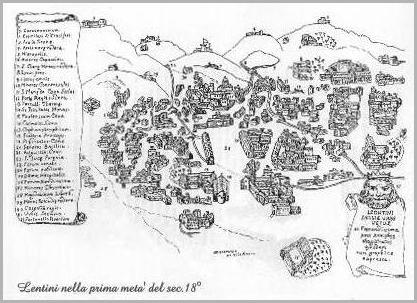Brief
history of Lentini

- Ancient
Leontinoi
-
- The
remains of ancient Leontinoi, administratively divided between the towns of
Lentini and Carlentini, comprise a suggestive archaeological park including
the traces of the prehistoric village of Metapiccola and the ruins of
Chalcidian and greek-Syracusan age.
- It
is possible to see the complex walls belonging to four different historical
perods, from the 7th to the 3rd century b.C..
The stretches around S.Mauro, that was the acropolis of the ancient town,
are well preserved.
- Interesting
are the 4th-3rd century b.C. Hellenistic necropolis of which it is possible
to see some sepulchres, the wide latomias, the bases of a Greek temple and
the remains of rectangular huts of a 9th- 8th century b.C. native village.
-
- Historical
Periods
-
- 729-427
b.c.
- founded
in 729 b.C. by the Chalcidians of Naxos, reached the very peak of its
splendour during the Greek colonization, it was antagonist of Syracuse in
427 b.C. when the lentinese Gorgia, one of the greatest solphist of the
antiquity, went to Athens to ask for helps for his city, fighting for a
States federation.
-
- 4th
century b.c. –roman age
- Fallen
under the rule of Syracuse, it became refuge and a point of support for
Dione against Dionysius the younger. Taken for a short time by the
Carthaginians, it was reconquered by Agathocles in 311. It fell later under
the Romans thanks to the consul Marcellus.
-
- 7th
– 13th century
- It
was bishop's seat under the Byzantines in the 7th century; suppressed the
diocese, it became for a short time feud of the Norman princes. The 1140 and
1169 earthquakes caused great damage in the town, that was rebuilt during
the Swabian period.
-
- 14th
century –1551
- Some
religious communities setled there enriched Lentini with churches and
convents, but the 1542 earthquake destroyed the town once again. The viceroy
Giovanni Vega wanted in 1551 the nearby Carlentini to be built to transfer
those who had suffered damages because of the earthquake. But they, not
content rebuilt their houses in the same place.
-
- 17th
century
- After
the complete destruction caused by the 1693 earthquake Lentini was entirely
rebuilt in the 17th century keeping the present urbanistic configuration
-
-
-
-